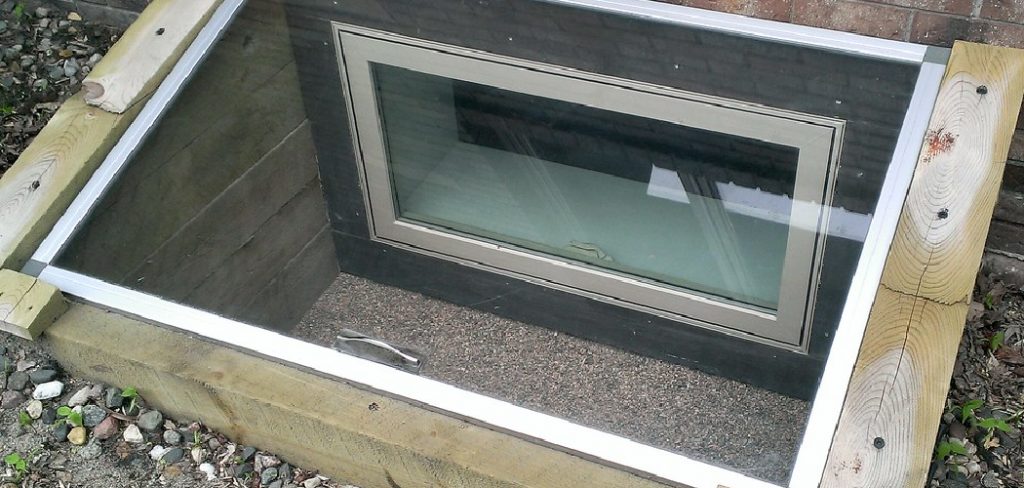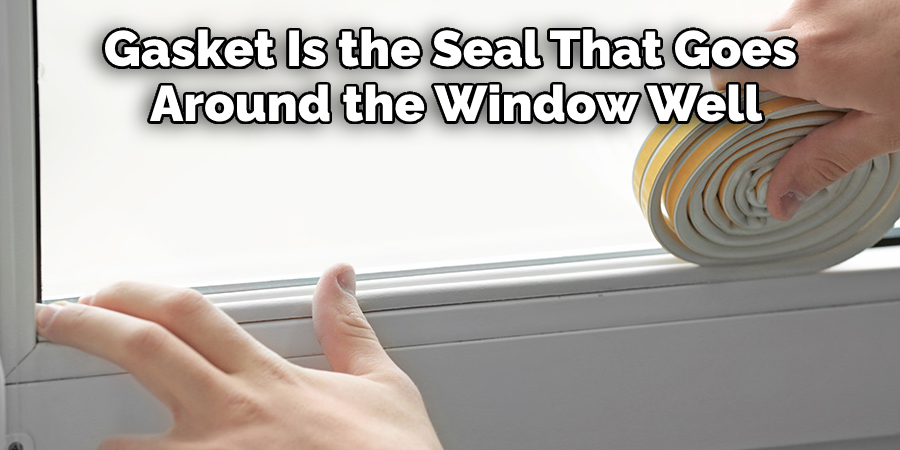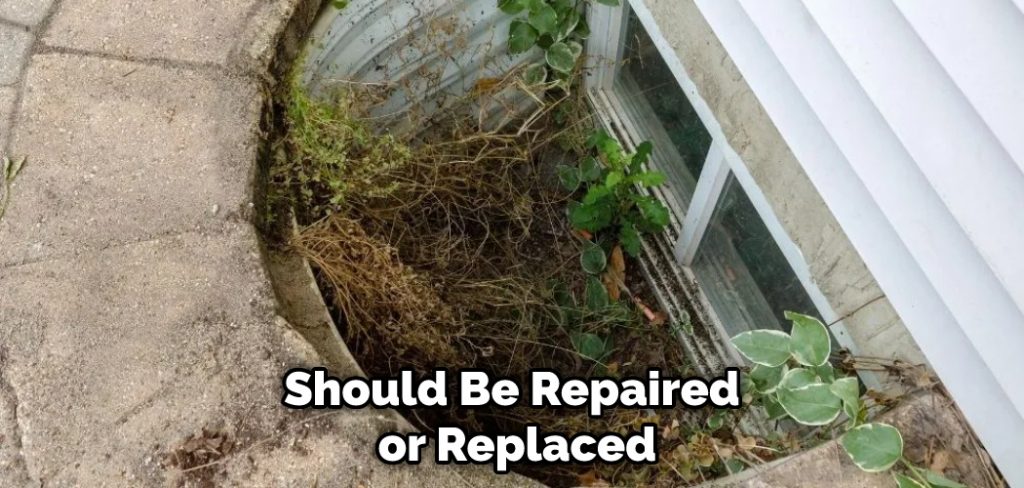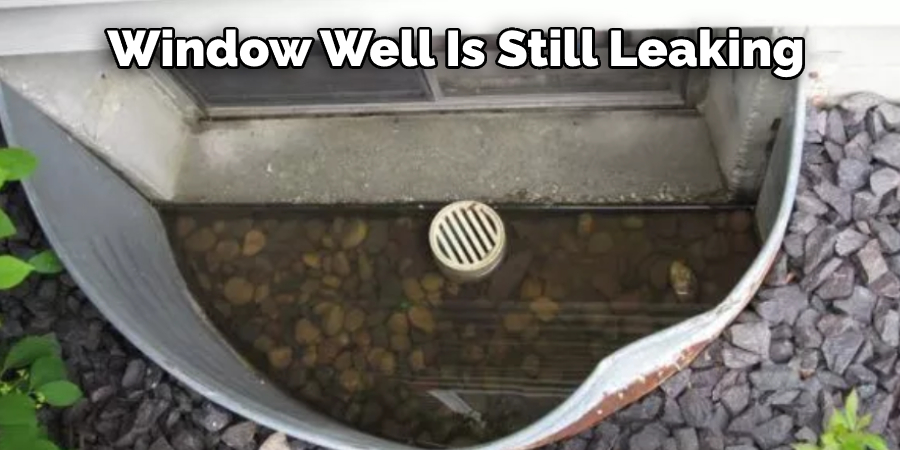Window wells are a common source of water infiltration in homes. If you have a leaking basement window, well, don’t panic! There are several ways to fix the problem. In this blog post, we will discuss different methods how to fix leaking basement window wells. We will also provide some tips on how to prevent future leaks. Let’s get started.

What Causes Window Wells to Leak?
There Are Several Reasons Why Window Wells May Leak, Including:
Broken Window Seals
One of the most common causes of window well leaks is broken window seals. Over time, the seals around your basement windows can degrade and break, allowing water to seep into your window wells and your basement.
Cracks in the Window Well
Window wells are made of concrete, brick, or stone. Over time, these materials can crack or crumble, allowing water to enter your basement. Cracks can also form if the window well is not installed properly.
Poor Drainage
If your window well does not have proper drainage, water can accumulate in the well and eventually leak into your basement. Window wells should have a drainage pipe to carry water away from the well and prevent flooding. Clogged gutters or downspouts can also cause poor drainage. If your gutters are not draining properly, water can back up and overflow into the window well.
Damaged Gaskets
If the gasket is damaged, water can leak into the window well, causing damage. In addition, gaskets can become damaged over time due to weathering or age, so it is important to check them regularly.

Rising Water Table
If your basement walls are thin, water can seep into the well and leak onto the floor, or even into the house. If your basement is in an area that sees a lot of rain or snowmelt, the water table may rise, causing water to leak into your well.
Clogged Drainage
If the drainage system around your window well is clogged, it can cause water to back up and enter your basement. Clogged drains can be caused by debris, leaves, or even animals nesting in the well. To prevent leaks, clogged drains should be cleaned out regularly.
Worn-Out Window Wells
Over time, window wells can become worn out and damaged. This can allow water to enter your basement through cracks or holes in the well. Worn-out window wells should be repaired or replaced to prevent leaks.

What Are the Signs of a Leaking Basement Window Well?
There are several signs that you may have a leaking basement window well. These signs include:
- Water stains on the walls or floor around the window well
- A musty smell in the area around the window well
- Mold or mildew growing in the area around the window well
- Cracks in the walls or floor around the window well
- Pooling water around the window well
- A gurgling sound coming from the drains in the window well
If you notice any of these signs, it’s important to fix the problem as soon as possible. Otherwise, you could end up with serious structural damage to your home.
Step by Step How to Fix Leaking Basement Window Wells
Step 1: Gather Necessary Tools and Materials
Before beginning the repair process, gather the necessary tools and materials for the job. These may include:
- Bucket or container (to collect water)
- Towels or rags
- Shovel
- Window well cover
- Gravel or crushed stone
- Trowel or garden rake
- Waterproof sealant or caulk
- Caulking gun
- Plastic sheeting or waterproof membrane
- Scissors or utility knife
- Drainage pipe or channel (if needed)
- Landscape fabric (optional)
Step 2: Remove Water from the Window Well
Begin by removing any standing water in the window well. You can use a bucket or container to scoop out the water or utilize a wet/dry vacuum if you have one. Remove as much water as possible to facilitate the repair process.
Step 3: Inspect the Window Well
Inspect the window well to determine the source of the leak. This may involve checking the window itself, the window well liner, and the surrounding area for cracks, gaps, or other issues that may be causing water infiltration.
Step 4: Clean the Window and Window Well
Clean the window and window well to remove any dirt, debris, or other obstructions that could be contributing to the leak. This will also ensure a clean surface for applying sealant or waterproofing materials.
Step 5: Seal Cracks and Gaps in the Window
If you find any cracks or gaps in the window or window frame, use a waterproof sealant or caulk to fill and seal these areas. Apply the sealant with a caulking gun, ensuring that the entire crack or gap is filled. Allow the sealant to dry according to the manufacturer’s instructions.
Step 6: Check and Repair the Window Well Liner
Inspect the window well liner for any damage, such as cracks, holes, or deterioration. If necessary, repair or replace the liner to ensure that it is providing adequate protection against water infiltration.
Step 7: Install a Window Well Cover
If your window well does not already have a cover, consider installing one. Window well covers can help to prevent water from entering the well and causing leaks, as well as reducing the amount of debris that accumulates in the well.
Step 8: Improve Drainage in the Window Well
One of the most common causes of leaking window wells is poor drainage. To improve drainage, remove any debris or obstructions from the bottom of the well and add several inches of gravel or crushed stone. Use a trowel or garden rake to level the gravel and ensure that it slopes away from the window.
Step 9: Install a Drainage System (if necessary)
If poor drainage continues to be an issue, consider installing a drainage pipe or channel in the window well. This can help to direct water away from the window and prevent it from pooling in the well.
Step 10: Waterproof the Exterior Wall
To further protect your basement from leaks, apply a waterproof membrane or plastic sheeting to the exterior wall around the window well. This can help to prevent water from seeping through the wall and into your basement. Cut the sheeting to the appropriate size and attach it to the wall using waterproof adhesive or tape.
Step 11: Landscape Around the Window Well
To prevent water from pooling near the window well and causing leaks, ensure that the surrounding landscape slopes away from the well. This may involve adding soil, adjusting the grade, or installing a French drain to direct water away from the foundation.
Step 12: Monitor the Window Well
After completing the repair process, continue to monitor the window well and basement for signs of leaks or water infiltration. If you notice any issues, address them promptly to prevent further damage to your basement.
By following these teps, you can effectively repair a leaking basement window well and prevent future water infiltration. Proper maintenance and attention to drainage and waterproofing measures will help to protect your basement from damage and keep it dry and comfortable.
Step 13: Maintain Regular Inspections
Regularly inspect your window wells and basement for any signs of leaks, water infiltration, or damage. By catching any issues early on, you can prevent more extensive damage and costly repairs in the future.
Step 14: Keep Gutters and Downspouts Clear
Ensure that your home’s gutters and downspouts are free of debris and functioning properly. This will help to direct rainwater away from your home’s foundation and window wells, reducing the risk of leaks and water infiltration.
Step 15: Check for Proper Grading
Ensure that the soil around your home slopes away from the foundation. Proper grading will help to direct water away from your home and prevent it from pooling near your window wells.
Step 16: Consider Installing a Sump Pump
If your basement is prone to flooding or leaks, consider installing a sump pump to help remove water and protect your basement. A sump pump can help to prevent water damage and keep your basement dry.
Step 17: Insulate Your Basement Windows
To help reduce condensation and moisture buildup on your basement windows, consider insulating them with window insulation kits or adding insulated window coverings. This will also help to improve energy efficiency and keep your basement more comfortable.
Step 18: Ventilate Your Basement
Ensure that your basement is well-ventilated to prevent the buildup of moisture and reduce the risk of leaks and water infiltration. This may involve installing exhaust fans, opening windows and vents, or using a dehumidifier to help control humidity levels.
Step 19: Regularly Clean Your Window Wells
Keep your window wells clean and free of debris by regularly removing leaves, dirt, and other obstructions. This will help to maintain proper drainage and reduce the risk of leaks.
Step 20: Schedule Professional Inspections
Schedule regular professional inspections of your home’s foundation and drainage systems. This will help to identify any issues early on and ensure that your home is well-protected against leaks and water infiltration.
By following these steps and maintaining your basement window wells, you can effectively prevent leaks and water infiltration, keeping your basement dry and comfortable. Regular care and maintenance will help to protect your home and ensure its longevity, providing a safe and enjoyable living environment for you and your family.
You Can Check It Out To Fix Roof Condensation

How Much Does It Cost to Fix a Leaking Basement Window Well?
The cost to fix a leaking basement window well can vary depending on the severity of the problem. In most cases, you can expect to pay between $100 and $500 to fix a leaking window well. However, in some cases, the cost can be much higher. For example, if you need to replace the window well, the cost can range from $500 to $2,000.
How Long Does It Take to Fix a Leaking Basement Window Well?
The amount of time it takes to fix a leaking basement window well can vary depending on the severity of the problem. In most cases, it will take between 1 and 2 hours to fix a leaking window well. However, in some cases, it can take much longer. For example, if you need to replace the window well, it can take 4 to 8 hours to complete the job.
Frequently Asked Questions
What Do You Fill Window Wells With?
If you’re looking to save energy and water, one way to do this is by filling your window wells with rocks or gravel. By doing this, you reduce the amount of air that enters your home during the summer months and winter hours when it’s cold outside. This helps conserve energy because less heat needs to be generated inside the home. In addition, by reducing transmittance from glass surfaces, window wells can help regulate indoor temperatures more efficiently and save on cooling costs in hot weather.
It is also important to keep an eye out for pests while filling window Wells as they may find refuge there if not kept clean.
Why Does My Window Leak When It Rains?
Water can often seep through cracks and joints in windows (and other exterior surfaces) due to a variety of factors, such as poor construction, settling or corrosion. When it rains, the water can accumulate on the window and cause it to leak. In some cases, the water may be able to get inside the building through the window.
There are a few things that you can do to minimize the chances of your window leaking during rain:
- Make sure your windows are caulked and sealed properly – Caulking and sealing windows can help keep water out and protect your building from moisture damage.
- Install window guards – Window guards are protection against burglary and vandalism. They help keep rain or other debris from entering through the window and damaging the interior of your building.
- Check for leaks – If you notice any water seeping through cracks or joints in your windows, make sure to check for leaks and address them as soon as possible.
Should Window Well Drains Be Filled With Gravel?
There are pros and cons to filling your window well drains with gravel. The benefits of doing this include the prevention of mosquitoes from breeding in your home, reduced noise levels, and a cleaner appearance. On the other hand, some people may be concerned about potential drainage issues or damage that might occur if debris is thrown into the well during stormy weather.
Ultimately, it’s best to contact a professional plumber to assess whether or not gravel should be used as a filler for window wells. They will also be able to give you specific instructions on how much material needs to be added and when it should be done so that it doesn’t affect drainage in any way.
Can You Put a Sump Pump in a Window Well?
A sump pump is designed to be installed in areas where there is a lot of water waste, such as near the floor of a basement or in an attic. The sump pump should not be placed in a window well because the force of wind and rain could cause it to malfunction.
Conclusion
This article has provided a wealth of information on how to fix leaking basement window wells. Hopefully, you now have a better understanding of the problem and the different solutions that are available. If you have a leaking basement window well, don’t despair. There are several ways to fix the problem, most of which are easy and inexpensive. Follow these simple steps, and your leaky window well will be fixed in no time.
